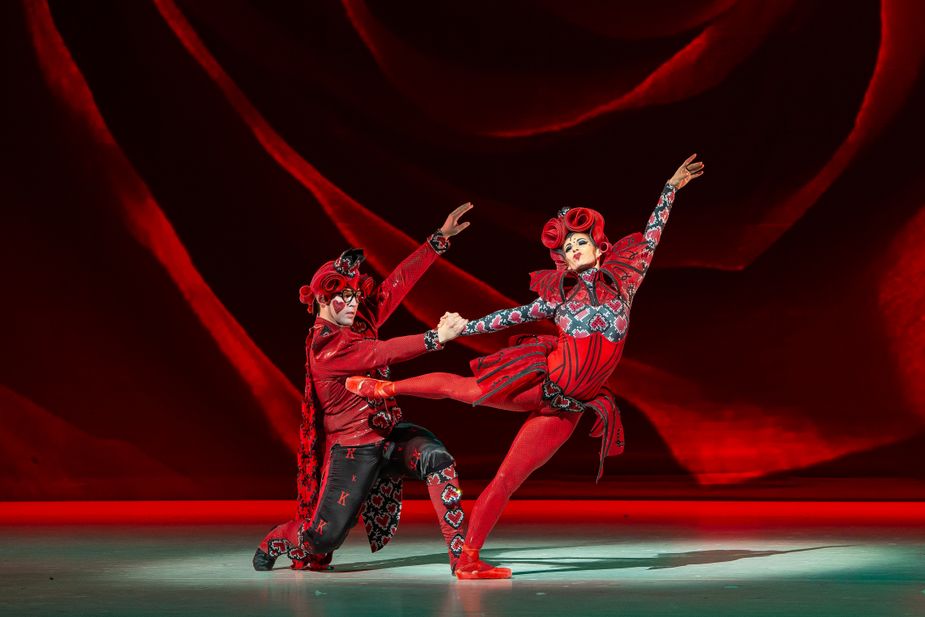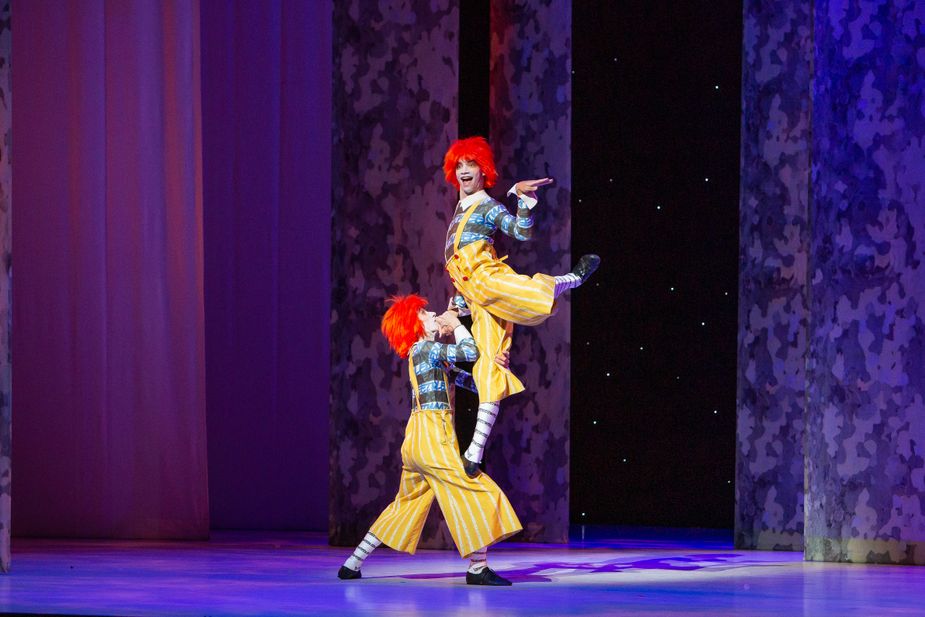Behind the Looking Glass, Act III: In Full Bloom
Published October 2021
By Karlie Ybarra | 8 min read
Read the first two parts of Karlie Ybarra's series here:
Behind The Looking Glass, Act I: From The Page To The Stage
Behind The Looking Glass, Act Ii: The Flowers Come To Life

It’s hard to believe someone so beautiful can be so terrifying, but the Red Queen strikes fear into the hearts of everyone—including her Red King and the audience. Photo by Jana Carson
“If I had a world of my own, everything would be nonsense. Nothing would be what it is, because everything would be what it isn't. And contrary wise, what is, it wouldn't be. And what it wouldn't be, it would. You see?”
In Septime Webre’s Alice (in wonderland), the Oklahoma City Ballet creates exactly the weird and wonderful world Lewis Carrol’s heroine dreamed of.
Act III: In Full Bloom
When the audience first joins Alice, she’s enjoying a pleasant if dull day at home with her family. Her twin sisters frolic about, her mother terrorizes the butler, the cat causes a ruckus—all is as it should be in this ordinary existence. But Alice flits across the stage, a stark contrast in shimmering cyan to the minimalist black and white scene.
Leaving the safety of the family home, Alice ventures alongside Lewis Carroll into the forest. The crew accomplishes this trick of geography with a some lighting adjustments and floor-to-ceiling banners patterned like bark—a simple but creative and convincing effect. Among the towering trees, Alice catches her first glimpse of the white rabbit. Though he never says a word, his nervous energy, frantic movements, and timepiece-clad wardrobe convey a comical sense of urgency that’s impossible to ignore. Naturally, Alice follows, and she soon finds herself tumbling down, down, down into a wonderland aglow with color.

The tea party attendees enjoy a brief moment of repose after a chaotic affair. The action rarely stop in "Alice," but the opportunity to take in Liz Vandal’s beautiful costumes is welcome. Photo by Diana Bittle
While there are many scenes in Alice (in wonderland) that require an astounding level of collaboration, perhaps one of the most visually delightful is her encounter with a flock of flamingoes, a nod to Swan Lake’s graceful avians. Unlike flamingoes in the wild, which tend to shuffle somewhat awkwardly, these dancers are perfectly in sync, their gliding and preening as fluid and natural as breathing. This is especially impressive given the foot-tall beaks on their heads. When a troop of fluffy baby flamingoes files in—students from the Yvonne Chouteau School—the audience literally cannot contain a chorus of “awwws.”
During the infamous tea party, James Kronzer’s set design is a Technicolor marvel—think Andy Warhol redecorates Willy Wonka’s chocolate factory. A Wonka-esque Mad Hatter leads the revelry, dancing on top of the table with the Doormouse and the March Hare. Liz Vandal’s brilliant costuming is a little mad too: The Hatter’s jacket is covered in stacks of top hats, for instance. But Vandal, who also designs costumes for Cirque du Solei, outdoes herself with the caterpillar’s attire—a Prussian blue body suite outlined with intricate corsetry details, edged with cascading fringe along the legs, and a majestic onyx headpiece to top it all off. As a group of male dancers carry her across stage, she’s one continuous, undulating wave of blue and glittering black. When she ascends to the sky and her azure wings fill the stage, the audience explodes with applause.

The practical effects used throughout "Alice" are ingenious. Swapping large doors for tiny ones and adult dancers for children help grow our heroine into an elegant giantess—no magic cookies needed. Photo by Jana Carson
It’s difficult not to wax poetic about every single costume—the Red Queen might be evil, but she looks absolutely devastating in a red and black body suite with a high collar, sparkling hearts, and just enough bustle to reinforce her grandiosity. And that gravity-defying coiffure reminds the audience that this royal won’t even stand for one of her own hairs to defy her.
However, Vandal’s wardrobe—in fact, every aspect of the production—really shines thanks to Clifton Taylor’s lighting design. Ever present but not overbearing, Taylor’s effects make each scene richer and more emotionally impactful. When the horrifying jabberwocky slithers in—each of its body parts operated by at least one dancer-turned-puppeteer—the stage is saturated with violet and fuschia rays, setting the scene for a battle of the ages.
As if the panoply of visual delights weren’t enough already, hearing the Oklahoma City Philharmonic perform Matthew Pierce’s original score live, conducted by the man himself . . . it envelops the audience and carries them along for the ride. Every emotion is amplified by this sometimes jazzy, sometimes chilling, always masterful arrangement.
There were a number of surprises throughout the production (no spoilers here!). But one of the most pleasant of which was how funny Alice (in wonderland) is. Ballet can often feel very serious, but when Tweedledee and Tweedledum descend into disco dancing in their oversized overalls, audience members young and old laugh out loud. In fact, just about every scene has moments of levity—sometimes even when the dancers are levitating.

Whether they’re riding through the air on the back of a bicycle or disco dancing their hearts out, the Tweedles elicit an uproar of laughter and applause whenever they’re on stage. Photo by Jana Carson
“I think one of the things that ballet struggles with the in the twenty-first century is people’s perception of it,” says Robert Mills, Oklahoma City Ballet’s artistic director. “They feel like there is something they really need to understand. Maybe they feel like there is something culturally they have no experience with, so they can’t connect to it. With Alice (in wonderland) Septime Webre worked with talented people to create a production that’s very accessible to today.”
Clever, hilarious, colorful, and absolutely mad: Alice is a festival for the senses from beginning to end carried off brilliantly on the shoulders of insanely talented dancers. It’s not your grandmother’s ballet, as Mills says with a laugh: It’s a adventure that people of all ages and demographics will dream about for years to come.







